Introduction
Micro Focus Operations Manager i acts as a single pane of glass, allowing you to be in control of your IT environment. It enables you to automate continuous discovery and IT event monitoring so you can sense the state of IT resources and how it impacts your business. OpsRamp integration supports to accept events from OMi as alerts.
OpsRamp configuration
Configuration involves the following:
- Installing the integration.
- Configuring the integration.
Step 1: Install the integration
To install:
- From All Clients, select a client.
- Go to Setup > Integrations > Integrations.
- From Available Integrations, select Monitoring > Micro Focus Operations Manager i.
- Click Install.
Step 2: Configure the integration
To configure the integration:
- From the API tab, provide the following:
- Authentication: Copy Tenant Id, Token and Webhook URL for configuration. These settings are used for creating a HTTP Request template.
- Map Attributes: Provide the mapping information for the third-party.
- From the Monitoring of Integration tab, click Assign Templates.
- From the Audit Logs, set up audit log criteria and time frame.
Configuring the map attributes
To configure the mapping attributes:
- Select the required OpsRamp property from the drop-down.
- Click Add Mapping Attributes to map attributes for the specific OpsRamp alert property.
- Click + to define the mappings.
- From Create Alert Mappings on Status, define the mappings, parsing conditions, and default values, and Save.
The following tables shows the attribute mappings and a sample payload. The sample payload with OMi event details that appears in OpsRamp after the integration. Depending on the mapping of properties, data is displayed in OpsRamp.
| OMi payload | OMi Attributes | OpsRamp Attributes | |||||||||||
|---|---|---|---|---|---|---|---|---|---|---|---|---|---|
{
"event": {
"subject": "Memory utilization is high",
"description": "Memory utilization is high",
"createdTime": "2018-01-10 07:58:42",
"receivedTime": "2018-01-10 07:58:42",
"id": "13492360-f5dc-71e7-0c4e-ac1a6f660000",
"ciInfo": {
"ciId": "ed363fe71d376d23febcd5ee2938b51a",
"ciName": "omi",
"ciDNS": "omi.or.com"
},
"category": "OS",
"subCategory": "",
"application": "a",
"object": "o",
"severity": "critical",
"state": "open",
"priority": "medium",
"policyName": "opcmsg_test(1.0)"
}
} | event.id | External Alert ID | |||||||||||
| event.severity | Alert state
| ||||||||||||
| event.subject | Alert subject | ||||||||||||
| event.description | Alert description | ||||||||||||
| event.createdTime | Alert time | ||||||||||||
| event.category - $event.subCategory | Alert metric | ||||||||||||
| event.ciInfo.ciName | Alert resource name |
OMi configuration
The Connected Servers Manager is used to configure the target servers. These server receive forwarded events and subsequent event changes.
Configuration involves:
- Configuring the OpsRamp server.
- Configuring external event processing.
- Configuring event forwarding rules.
Step 1: Configure OpsRamp server
In this step, OpsRamp is configured as a target connected server in OMi Connected Servers Manager. OMi events and subsequent event changes are posted to OpsRamp.
Note
OpsRamp supports the integration via the Call Script Adapter.To configure OpsRamp as a connected server:
- Login to OMi.
- Go to Administration > Setup and Maintenance.
- From the Connected Servers pane, click the New Script icon to create new script and provide the following:
- In General section:
- Display Name: Provide a name for the script. The script would be identified with this name. Example: OpsRamp Push Event Adapter.
- Description: Provide a summary describing the script. Example: Push OMi events to OpsRamp via groovy script.
- Click Next.
- In the Script section: Provide the script and click Next.
- Note: Use the Tenant ID and Token values from the OpsRamp comfiguration.
- For example:
/integrations/alertsWebhook/client_27/alerts?vtoken=wZjQ9V3CmGYXzmukLzPpQ6xzJVHEju5P
- In the Advanced section: Provide the time out as 60000 ms and click Finish.
- In General section:
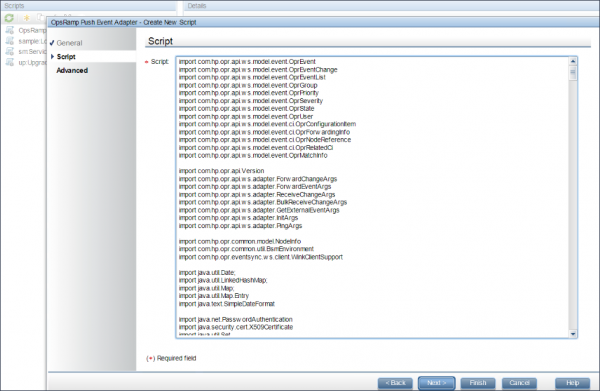
OMi Script
Step 2: Configure external event processing
To configure the external event processing:
- Go to Administration > Setup and Maintenance.
- On the Connected Servers pane, click the New Script icon and then click External Event Processing.
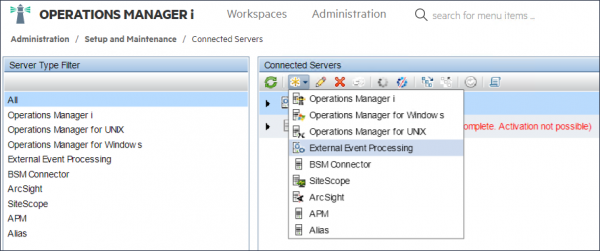
External Event Processing
- In the General section, provide the following:
- Display Name: Provide a name for OpsRamp connected server.
- Name: Provide a unique internal name. You can change the internal name if you want to change the automatically generated name.
- Description: Provide a description of the connection.
- Select Activate External Event Processing Server after creation and click Next.
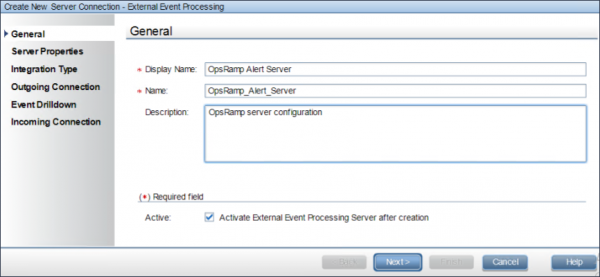
External Event Processing
- In Server Properties section, configure the following:
- Fully Qualified DNS Name: Provide OpsRamp DNS name api.vistanet.jp
- CI Type: Select Management System from the drop-down.
- Customize the way events and change notifications are delivered to OpsRamp server using Advanced Delivery Options, and then click Next.
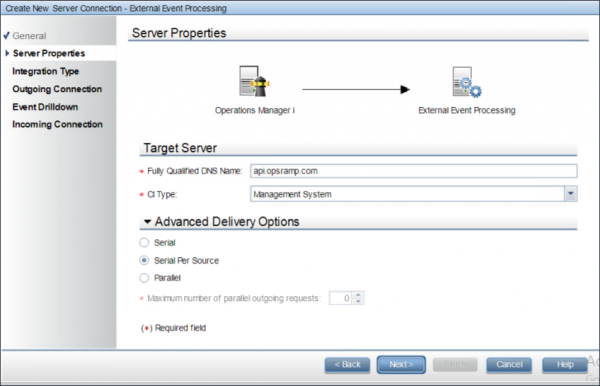
External Event Processing Server Properties
- In Integration Type section, configure the below details:
- Select Call Script Adapter, select the previously configured Script name from the drop-down.
- Provide the time limit for execution of the script and click Next. Note: Default time limit is 60 seconds.
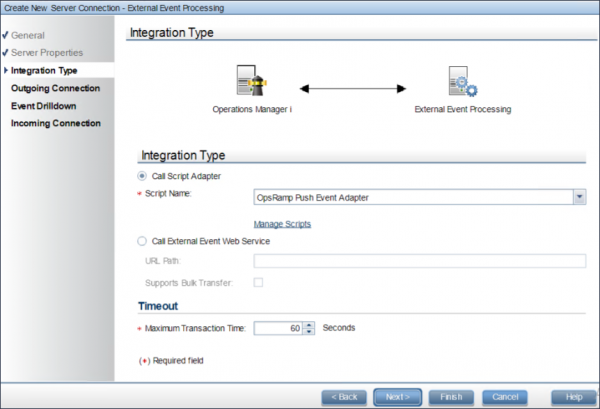
External Event Processing Integration Type
- In Outgoing Connection section, configure the following:
- Provide port number as 443. The events are forwarded to OpsRamp server.
- Select Use Secure HTTP, click on Retrieve from Server to fetch OpsRamp certificate and click Next.
Username and password are optional.

External Event Processing Outgoing Connection
- In Event Drilldown section, configure the following:
- Select Use Secure HTTP for secure communication and click Next.
- In Incoming Connection section, the username is auto-generated. Leave this section blank and click Finish.
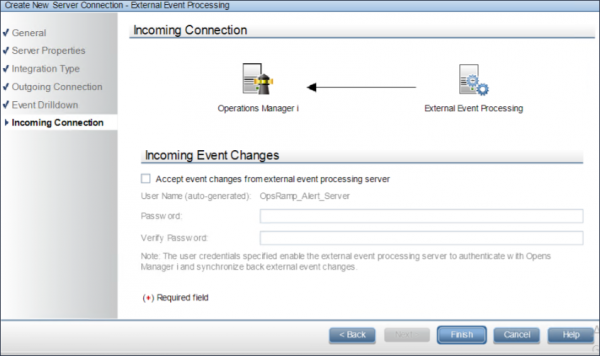
External Event Processing Incoming Connection
Step 3: Configure event forwarding rules
Configure an event forwarding rule to determine which events are forwarded to OpsRamp connected server. Events matching with the rules are pushed to OpsRamp connected server along with the subsequent changes in the events. You can configure which events to forward based upon a filter, and to which connected server the events should be forwarded. You can configure filters in the Event Forwarding manager.
To configure event forwarding rules:
- Go to Administration > Event Processing.
- From Automation, click Event Forwarding and click the New Script icon to create a new event forwarding rule.
- In the General section, configure the following:
- Name for the rule.
- Rule description.
- In Condition section, configure the following:
- Click browse icon and select the filter. The filter determines which events to forward. For example, a filter can contain severity related attributes to forward only Critical or Major events.
- To create a new filter, configure the the following:
- Click the New Script icon and click New Simple Filter.
- Provide name for filter. Example: OpsRamp Push Events Forward Rule.
- Provide description of the filter.
- Configure General, Dates and Additional Event Properties as per your requirement.
- Click All events in Correlation section, and then click OK.
The rule now appears in the Event Filter drop-down in Conditions section.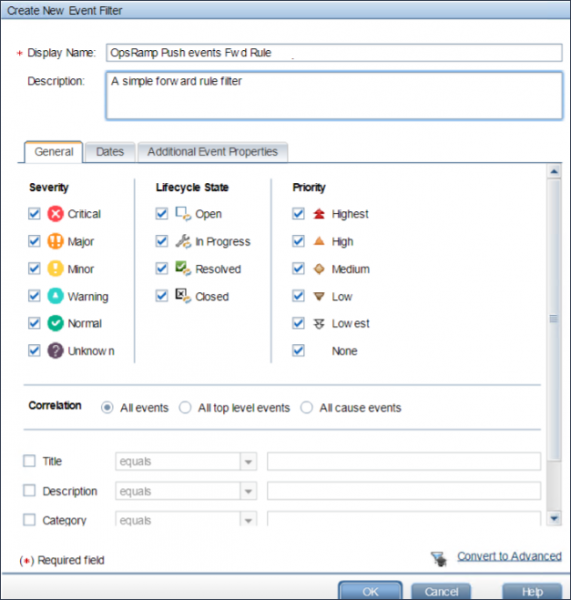
Event Forwarding Rule Condition
- In Target Servers section, configure the below details:
- Select the previously configured OpsRamp connected server from the drop-down.
- Click the Add multiple servers icon to view the target server details.
- Select Notify and Update in Forwarding Type drop-down and then click OK.
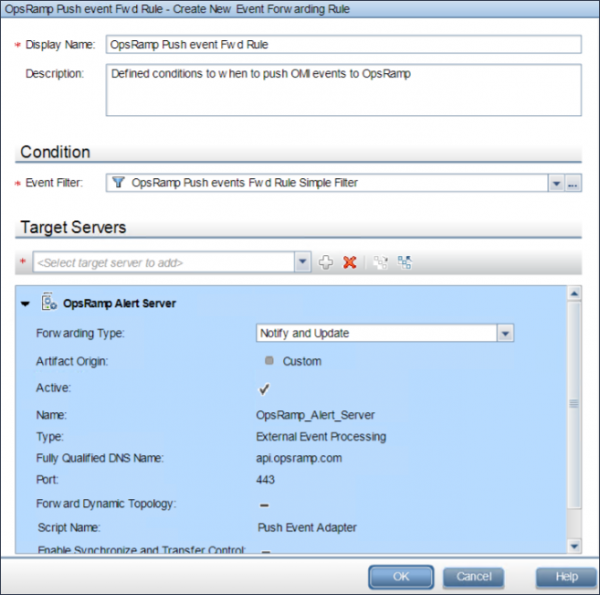
Event Forwarding Rule